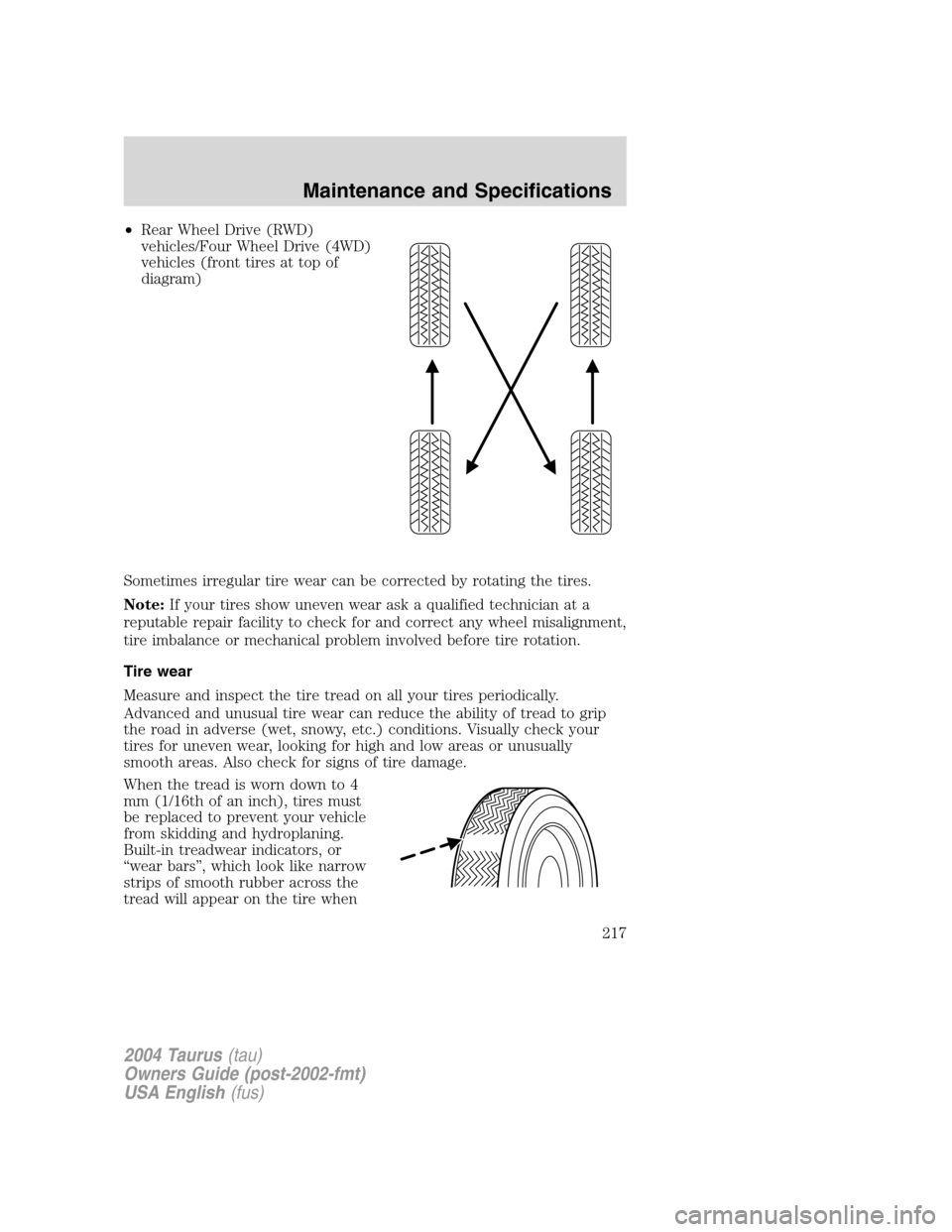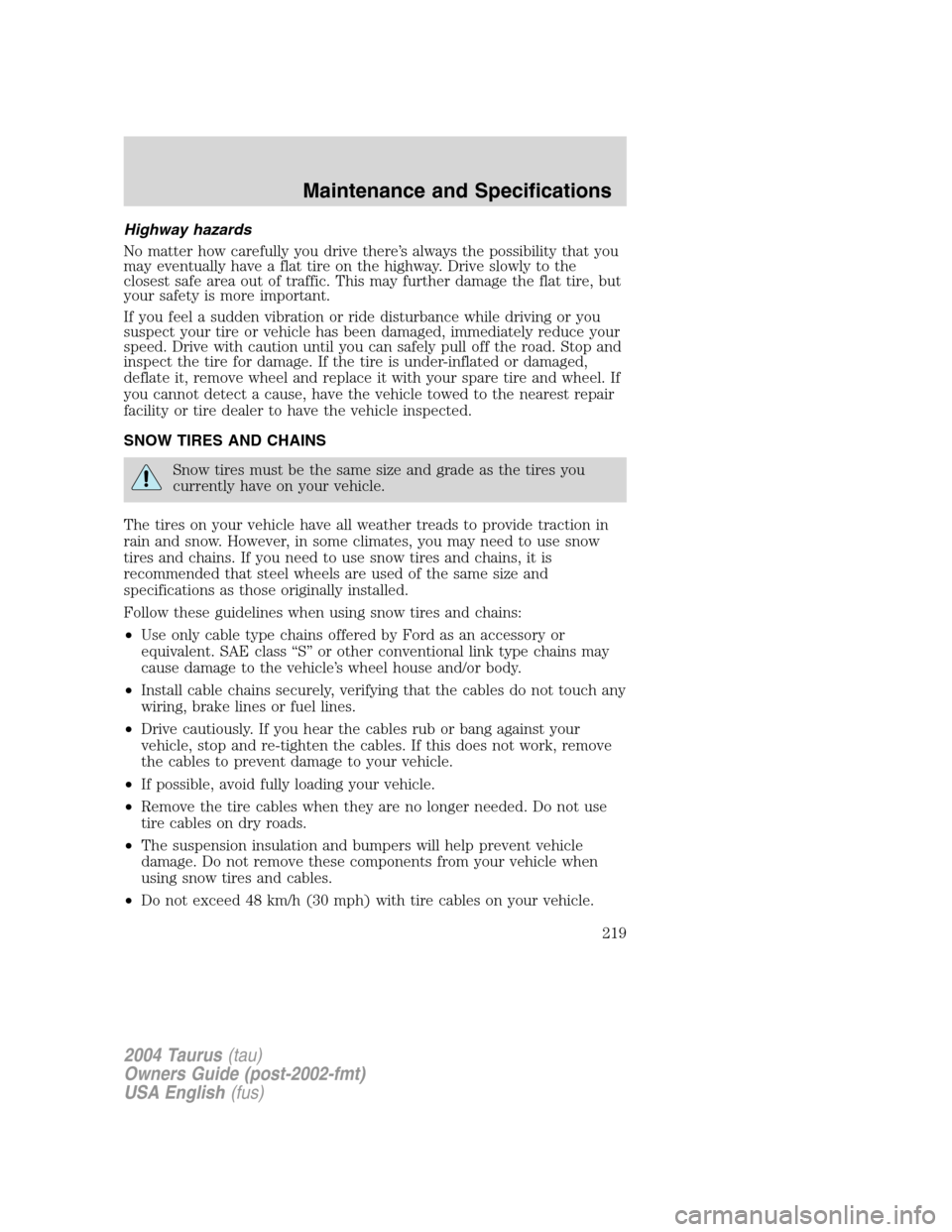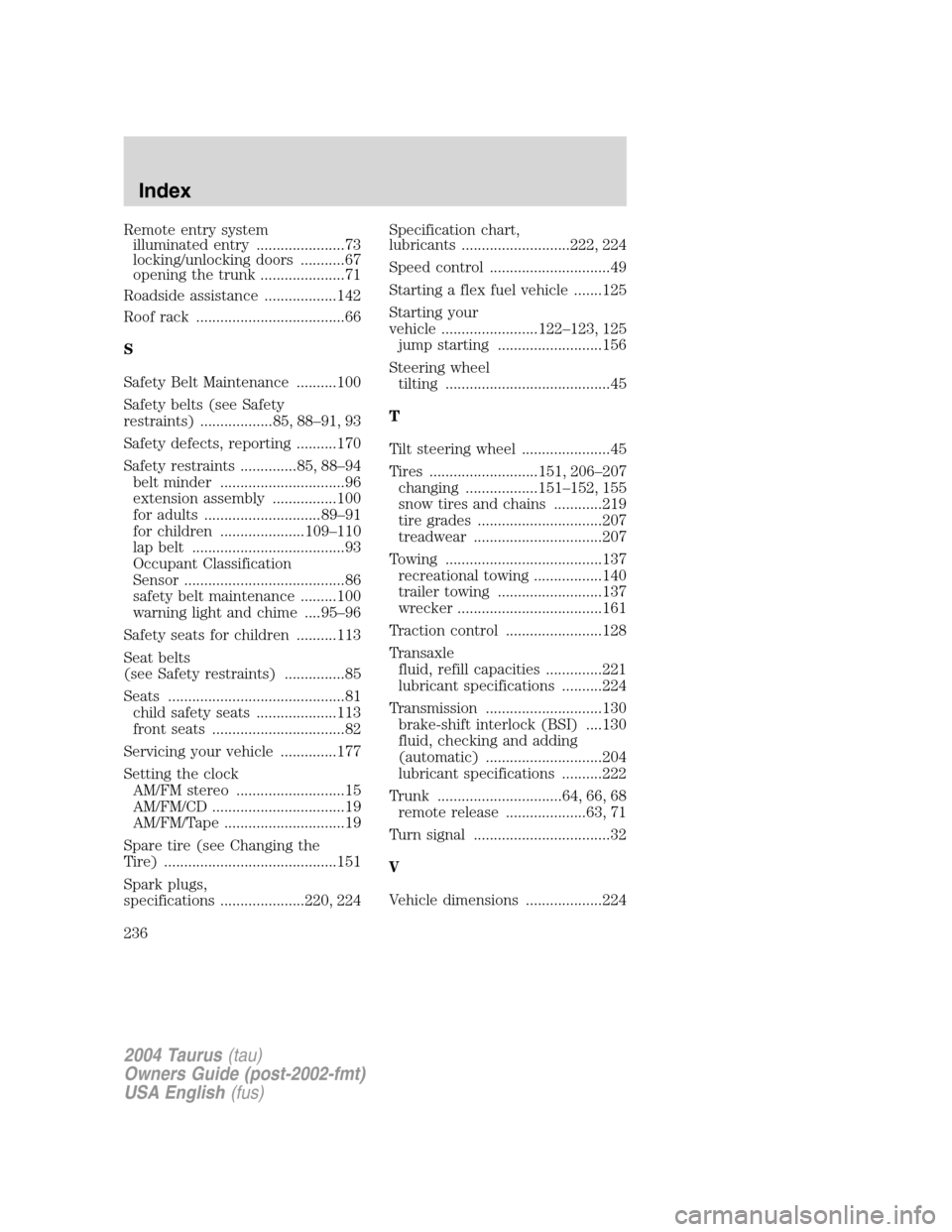Page 216 of 240
•Front Wheel Drive (FWD)
vehicles (front tires at top of
diagram)
2004 Taurus(tau)
Owners Guide (post-2002-fmt)
USA English(fus)
Maintenance and Specifications
216
Page 217 of 240

•Rear Wheel Drive (RWD)
vehicles/Four Wheel Drive (4WD)
vehicles (front tires at top of
diagram)
Sometimes irregular tire wear can be corrected by rotating the tires.
Note:If your tires show uneven wear ask a qualified technician at a
reputable repair facility to check for and correct any wheel misalignment,
tire imbalance or mechanical problem involved before tire rotation.
Tire wear
Measure and inspect the tire tread on all your tires periodically.
Advanced and unusual tire wear can reduce the ability of tread to grip
the road in adverse (wet, snowy, etc.) conditions. Visually check your
tires for uneven wear, looking for high and low areas or unusually
smooth areas. Also check for signs of tire damage.
When the tread is worn down to 4
mm (1/16th of an inch), tires must
be replaced to prevent your vehicle
from skidding and hydroplaning.
Built-in treadwear indicators, or
“wear bars”, which look like narrow
strips of smooth rubber across the
tread will appear on the tire when
2004 Taurus(tau)
Owners Guide (post-2002-fmt)
USA English(fus)
Maintenance and Specifications
217
Page 218 of 240

the tread is worn down to 4mm (1/16th of an inch). When you see these
“wear bars”, the tire is worn out and should be replaced.
Inspect your tires frequently for any of the following conditions and
replace them if one or more of the following conditions exist:
•Fabric showing through the tire rubber
•Bulges in the tread or sidewalls
•Cracks or cuts on the sidewalls
•Cracks in the tread groove
•Impact damage resulting from use
•Separation in the tread
•Separation in the sidewall
•Severe abrasion on the sidewall
If your vehicle has a leak in the exhaust system, a road tire or the spare
tire may be exposed to hot exhaust temperatures requiring the tire to be
replaced.
Safety practices
Driving habits have a great deal to do with your tire mileage and safety.
•Observe posted speed limits
•Avoid fast starts, stops and turns
•Avoid potholes and objects on the road
•Do not run over curbs or hit the tire against a curb when parking
If you vehicle is stuck in snow, mud, sand, etc.,do notrapidly spin the
tires; spinning the tires can tear the tire and cause an explosion. A tire
can explode in as little as three to five seconds.
Tire explosions can cause death, personal injury or property
damage. Do not allow anyone to stand near, or directly ahead or
behind the spinning tire.
Never spin the tires in excess of the 55 km/h (35 mph) point
indicated on the speedometer.
2004 Taurus(tau)
Owners Guide (post-2002-fmt)
USA English(fus)
Maintenance and Specifications
218
Page 219 of 240

Highway hazards
No matter how carefully you drive there’s always the possibility that you
may eventually have a flat tire on the highway. Drive slowly to the
closest safe area out of traffic. This may further damage the flat tire, but
your safety is more important.
If you feel a sudden vibration or ride disturbance while driving or you
suspect your tire or vehicle has been damaged, immediately reduce your
speed. Drive with caution until you can safely pull off the road. Stop and
inspect the tire for damage. If the tire is under-inflated or damaged,
deflate it, remove wheel and replace it with your spare tire and wheel. If
you cannot detect a cause, have the vehicle towed to the nearest repair
facility or tire dealer to have the vehicle inspected.
SNOW TIRES AND CHAINS
Snow tires must be the same size and grade as the tires you
currently have on your vehicle.
The tires on your vehicle have all weather treads to provide traction in
rain and snow. However, in some climates, you may need to use snow
tires and chains. If you need to use snow tires and chains, it is
recommended that steel wheels are used of the same size and
specifications as those originally installed.
Follow these guidelines when using snow tires and chains:
•Use only cable type chains offered by Ford as an accessory or
equivalent. SAE class“S”or other conventional link type chains may
cause damage to the vehicle’s wheel house and/or body.
•Install cable chains securely, verifying that the cables do not touch any
wiring, brake lines or fuel lines.
•Drive cautiously. If you hear the cables rub or bang against your
vehicle, stop and re-tighten the cables. If this does not work, remove
the cables to prevent damage to your vehicle.
•If possible, avoid fully loading your vehicle.
•Remove the tire cables when they are no longer needed. Do not use
tire cables on dry roads.
•The suspension insulation and bumpers will help prevent vehicle
damage. Do not remove these components from your vehicle when
using snow tires and cables.
•Do not exceed 48 km/h (30 mph) with tire cables on your vehicle.
2004 Taurus(tau)
Owners Guide (post-2002-fmt)
USA English(fus)
Maintenance and Specifications
219
Page 236 of 240

Remote entry system
illuminated entry ......................73
locking/unlocking doors ...........67
opening the trunk .....................71
Roadside assistance ..................142
Roof rack .....................................66
S
Safety Belt Maintenance ..........100
Safety belts (see Safety
restraints) ..................85, 88–91, 93
Safety defects, reporting ..........170
Safety restraints ..............85, 88–94
belt minder ...............................96
extension assembly ................100
for adults .............................89–91
for children .....................109–110
lap belt ......................................93
Occupant Classification
Sensor ........................................86
safety belt maintenance .........100
warning light and chime ....95–96
Safety seats for children ..........113
Seat belts
(see Safety restraints) ...............85
Seats ............................................81
child safety seats ....................113
front seats .................................82
Servicing your vehicle ..............177
Setting the clock
AM/FM stereo ...........................15
AM/FM/CD .................................19
AM/FM/Tape ..............................19
Spare tire (see Changing the
Tire) ...........................................151
Spark plugs,
specifications .....................220, 224Specification chart,
lubricants ...........................222, 224
Speed control ..............................49
Starting a flex fuel vehicle .......125
Starting your
vehicle ........................122–123, 125
jump starting ..........................156
Steering wheel
tilting .........................................45
T
Tilt steering wheel ......................45
Tires ...........................151, 206–207
changing ..................151–152, 155
snow tires and chains ............219
tire grades ...............................207
treadwear ................................207
Towing .......................................137
recreational towing .................140
trailer towing ..........................137
wrecker ....................................161
Traction control ........................128
Transaxle
fluid, refill capacities ..............221
lubricant specifications ..........224
Transmission .............................130
brake-shift interlock (BSI) ....130
fluid, checking and adding
(automatic) .............................204
lubricant specifications ..........222
Trunk ...............................64, 66, 68
remote release ....................63, 71
Turn signal ..................................32
V
Vehicle dimensions ...................224
2004 Taurus(tau)
Owners Guide (post-2002-fmt)
USA English(fus)
Index
236
Page:
< prev 1-8 9-16 17-24